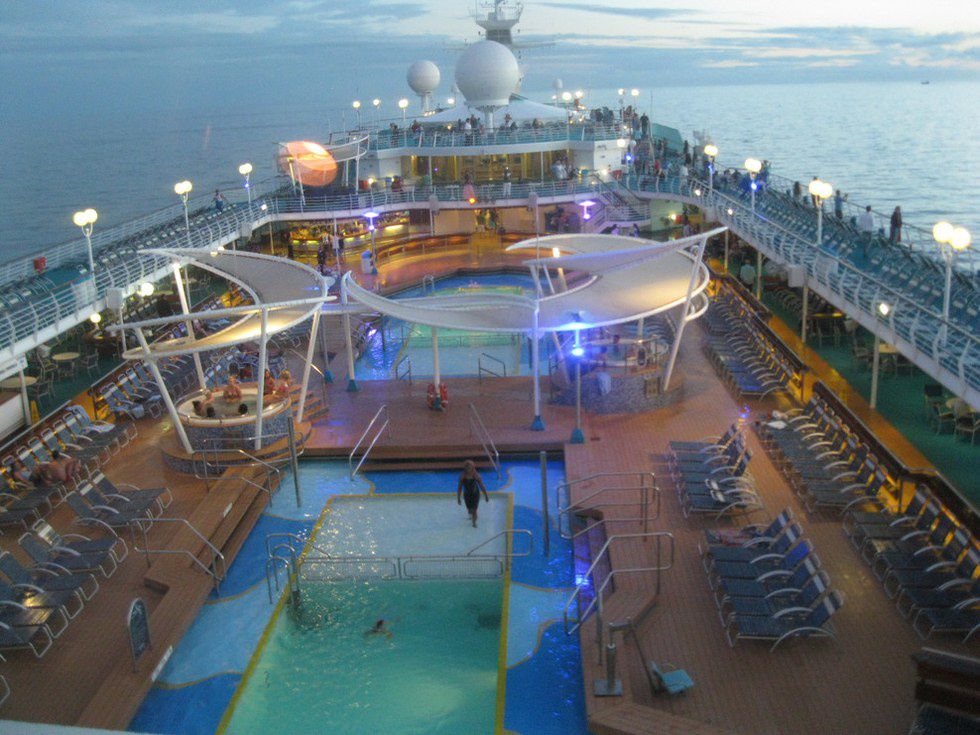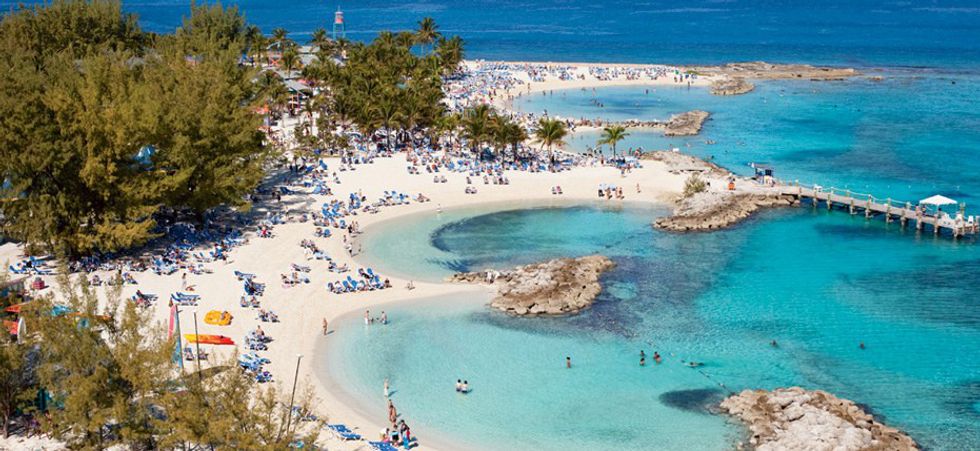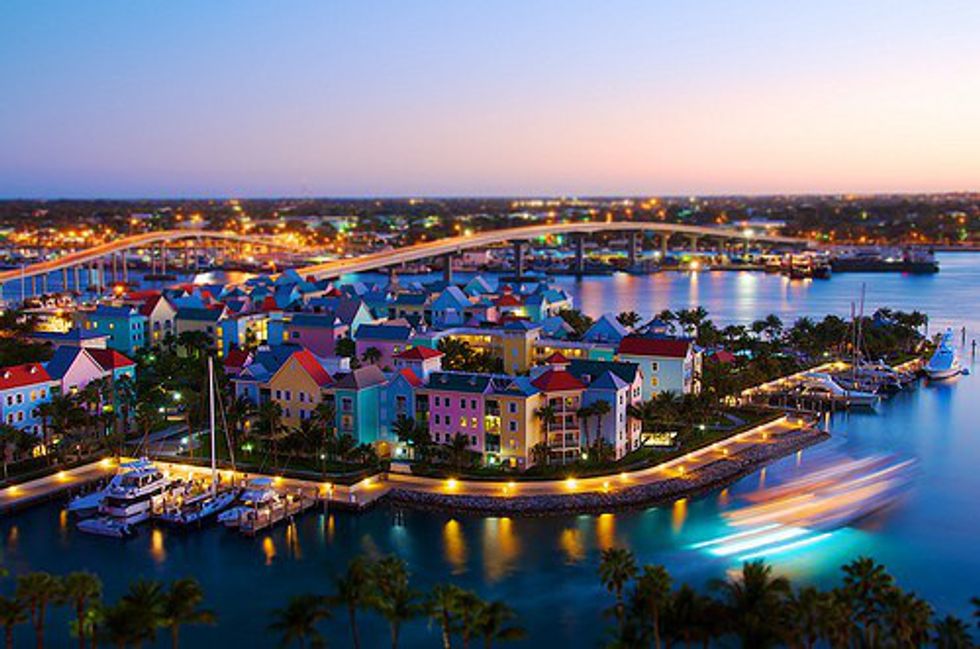As alluded to in a previous article, I promised you, the reader, that I would write a dissertation on my escapades in the Bahamas this past winter break. I am pleased to say that I do not plan to disappoint you in that regard. After four days aboard the Majesty of the Seas - which was my first cruise I might add - I am definitely not short of stories to tell you. I will namely be describing to you the three major aspects that stood out to on the cruise. Those namely included the following: the amenities on the Majesty of the Seas; Coco Cay; and Nassau, Bahamas. So without further or do, let us dive into the details.
The Majesty of the Seas
To start off with, the Majesty of the Seas is a Sovereign-class cruise ship owned by Royal Caribbean Cruises and operated by Royal Caribbean International. She was built at the Chantiers de l'Atlantique shipyards in Saint-Nazaire, France, and placed in service on April 26, 1992.
Majesty of the Seas is routinely used by Royal Caribbean on a 7-day cycle that includes two weekly voyages. Four-night cruises operate every Monday through Friday from the Port of Miami, stopping at Nassau, Coco Cay (a private island owned by Royal Caribbean), and Key West. A three-night cruise follows to Nassau and Coco Cay only each weekend.
Her features include the line-trademark Viking Crown Lounge overlooking the pool and sun decks. The ship has an on board casino and 11 passenger elevators, two of which are glass-walled. On board bars include the Schooner Bar, A Touch of Class Champagne Bar, Blue Skies Lounge, Boleros Latin Bar, On Your Toes Nightclub, Windjammer Café, and the Pool Bar. There are also two swimming pools, two hot tubs, a basketball court, and a rock climbing wall. The ship has 2,384 double occupancy and 346 triple-quad occupancy staterooms.
Most of these on board amenities I ended up skipping in favor of the off shores options in Coco Cay and Nassau - which I will talk about later in this article - but I still did partake in a few onboard ventures as well. Two that stick out to me particularly were the on board song and dance show Boogie Wonderland and the adult comedy show starring Jim McCue - one of the funniest comedians I have ever had the pleasure of seeing perform live. In addition to that, some minor pleasures that I enjoyed included but not limited to: classic rock trivia in the Schooner Bar; dinner in the Starlight on board dining experience (where I sampled the best New York Strip probably in my entire life thus far); and several on board drawings and game shows hosted be our cruise director - apply named Cruisin Susan - and her on board staff.
Coco Cay, Bahamas
Little Stirrup Cay or Coco Cay, Bahamas, is one of the Berry Islands, a collection of cays and small islands and is located approximately 55 miles north of Nassau. It is used for tourism by Royal Caribbean Cruises Ltd in an exclusive way. The island is less than a mile (around one kilometer) wide from east to west and less than 200 yards (183 meters) from north to south. It has a population of 38.(2010 census).
The east end is the center of recreational activities with beaches fronting a coral basin where manatee, rays, and numerous fish can be seen. There is a rocky inlet on the north side of the island large enough for the cruise ship tenders to operate from. Nature trails run the entire length and width of the island. Little Stirrup Cay is adjacent to Great Stirrup Cay, Norwegian Cruise Line's private island.
Royal Caribbean Cruises, which owns Royal Caribbean International, Celebrity Cruises, and Azamara Cruises, assumed the lease of the island upon acquisition of Admiral Cruises and renamed it Coco Cay, one of the first cruise lines to lease islands for their exclusive use. Royal Caribbean and Celebrity cruise ships frequently anchor off the island and bring passengers ashore by tenders. Activities available to guests include swimming, snorkeling, kayaking, parasailing, scuba diving, and WaveRunner piloting. Royal Caribbean extends its children's programs onto the island including a Fisher-Price-sponsored Power Wheels track for young children.
One of the main takeaway experiences that I took away, literally, with me from Coco, was the horrific sunburn that I procured while sunbathing on the pristine shores of the cay. Minus the burn, the weather was actually ideal for outdoor beach excursions. It was a nice warm day, buy not overwhelmingly humid. Making it perfect to stay outside and not sweat. A big shock to me in all honesty. The perfect winter time climate if you ask me.
Nassau, Bahamas
Nassau is the capital of the Bahamas. It lies on the island of New Providence, with neighboring Paradise Island accessible via Nassau Harbor bridges. A popular cruise-ship stop, the city has a hilly landscape and is known for beaches as well as its offshore coral reefs, popular for diving and snorkeling. It retains many of its typical pastel-colored British colonial buildings, like the pink-hued Government House. The city was named in honor of William III of England, Prince of Orange-Nassau.
Nassau's modern growth began in the late eighteenth century, with the influx of thousands of American Loyalists and their slaves to the Bahamas following the American Revolutionary War. Many of them settled in Nassau (then and still the commerce capital of the Bahamas) and eventually came to outnumber the original inhabitants. As the population of Nassau grew, so did its populated areas. Today the city dominates the entire island and its satellite, Paradise Island. However, until the post-Second World War era, the outer suburbs scarcely existed. Most of New Providence was uncultivated bush until Loyalists were resettled there following the American Revolutionary War; they established several plantations, such as Clifton and Tusculum. Slaves were imported as labor.
After the British abolished the international slave trade in 1807, they resettled thousands of Africans liberated from slave ships by the Royal Navy on New Providence (at Adelaide Village and Gambier Village), along with other islands such as Grand Bahama, Exuma, Abaco, and Inagua. In addition, slaves freed from American ships, such as the Creole case in 1841, were allowed to settle there. The largest concentration of Africans historically lived in the "Over-the-Hill" suburbs of Grants Town and Bain Town to the south of the city of Nassau, while most of the inhabitants of European descent lived on the island's northern coastal ridges.
Located on New Providence Island, Nassau has an attractive harbor, a colorful blend of old world and colonial architecture, and a busy port. The tropical climate and natural beauty of the Bahamas have made Nassau a popular tourist destination. Nassau developed directly behind the port area. New Providence provides 200 km² of relatively flat and low-lying land intersected by low ridges (none of which restricted settlement). In the center of the island, there are several shallow lakes that are tidally connected.
The city's proximity to the United States (290 km east-southeast of Miami, Florida) has contributed to its popularity as a holiday resort, especially after the United States imposed a ban on travel to Cuba in 1963. The Atlantis resort on nearby Paradise Island accounts for more tourist arrivals to the city than any other hotel property. The mega-resort employs over 6,000 Bahamians, and is the largest employer outside of the government.
Downtown is the hub for all activities in Nassau. Thousands of people visit daily, to shop, dine, sightsee and to enjoy the tropical climate of the city. While the busiest part of Downtown is the Bay Street thoroughfare and the Woodes Rogers Walk, located across the street from the port and parallel to Bay, the area extends for several blocks in each direction. It starts at West Bay, around the Junkanoo Beach area. A few hotels and restaurants are located on West Bay.
The next landmark is the British Colonial Hotel, which marks the beginning of Bay Street proper. Pirates of Nassau Museum is just across from the British Colonial Hilton. The next few blocks of Bay Street are wall-to-wall boutiques, with a few restaurants and clubs interspersed throughout the retailers. Famous historical landmarks are also in the vicinity, including Vendue House, Christ Church Cathedral, and the Nassau Public Library. Although the tourist part of Downtown peters out after about seven blocks, smaller, more local stores are found all the way down Bay Street. At this point, Bay Street becomes East Bay.
The new Straw Market is also a very busy place on a regular day. After the fire in 2001, it has been rebuilt to a new, more modern look. It consists of four sections that lead to Nassau Harbor in the back. Also in that area are many jewelry shops and bars. A next soon to be tourist hub is Pompey Square.
Cable Beach is recognized as the hotel district of Nassau. Five enormous hotels—two of which are all-inclusive—are located on this strip. The area is also known for its dining, the Crystal Palace Casino, and the golden sands of Cable Beach. Most of the area's restaurants are located either in the hotels or across the street. There is little to no nightlife. There is a bit of shopping, most of it located in the Wyndham. The commercial future of Cable Beach is being re-imagined with the development of Baha Mar, a resort and casino project that will bring more than 2,000 hotel rooms and the largest gaming and convention facility in the Caribbean to this section of New Providence Island, but the project has stalled at over 90 percent completion and the developers have declared bankruptcy.
Much of these breath taking sights I was able to see from the comfort of a taxi. Transport in and around the city is fairly cheap, but well worth the $30 per person dollar average price tag that comes with it. Included in the price, you get see a fair majority of what I already listed to you and last about 3-4 hours depending on your driver. Our driver, Alfred, offer a mix of in depth knowledge in regards to the history and culture of Nassau, as well as comic relief when it was need most.
Very much enjoyed the tour as well as the broader cruise experience itself. I can definitely see myself going on more cruises in the future. And I highly recommend going on at least one if you, the reader, if you have not already. My experience I hope is one of many stupendous venture I hope to partake in. Until next time, it was a pleasure setting sail with her Majesty.





















